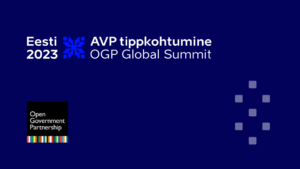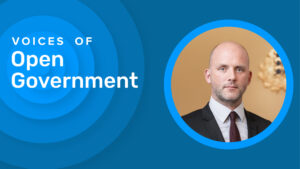Estonia’s Journey of Open Government Reforms
A member of the European Union (EU) since 2004 and the Organization for Economic Co-operation and Development since 2010, Estonia is widely considered one of the most developed post-communist countries, with well-consolidated democratic institutions. It has also earned praise as a global leader in e-government and joined the Open Government PartnershipThe Open Government Partnership (OGP) is a multi-stakeholder initiative focused on improving government transparency, ensuring opportunities for citizen participation in public matters, and strengthen... More (OGP) in 2011.
Now co-chairing the OGP Steering Committee, Estonia will host the 8th OGP Global Summit this September. It will be a key moment to deliver OGP’s new strategy, a ‘global action plan’ for the Partnership for the next five years. Over the course of six action plans, Estonia has demonstrated a strong ability to foster cultural changes through OGP. Open government reformers have institutionalized co-creation and strengthened participation in policy-making, improved transparencyAccording to OGP’s Articles of Governance, transparency occurs when “government-held information (including on activities and decisions) is open, comprehensive, timely, freely available to the pub... More of government decision-making, and embedded openness at the municipal level.
Here is a look back at these major achievements and an exploration of what the future holds for Estonia in OGP.
Empowering citizen voice in policy-making
Electronic governance and online participation for citizens have long been priorities for the Estonian government. During the country’s second OGP action plan (2014-2016), the Eesti Koostöö Kogu (Estonian Cooperation Assembly) launched rahvaalgatus.ee (“Citizen Initiative”). This platform allows citizens to easily crowd-source, prioritize, and vote on policy proposals to send to the Riigikogu (Parliament) and local governments. The platform is widely used by citizens, and several petitions have led to policy changes, particularly in environmental protection. By 2022, 50,000 people signed their support for local initiatives, such as preserving schools, libraries, and community centers in danger of disappearing.
Through OGP processes, the government has also gathered input from users on the requirements for a new co-creation tool for citizens and policymakers to access the full cycle of policy development. Through its current action plan (2022-2024), the Government Office is developing a pilot version of the tool, which will enable the public to submit comments in legislative drafting processes. Government agencies will be required to use the tool for all policy-making once it is ready. To help policymakers, the Government Office created an online toolbox (“Koosloomeranits”) as a resource to access co-creation methods, guidelines, and real-life case studies.
The government is also testing best practices in real-life co-creation scenarios. For example, the Government Office used the “Arvamusrännak” (“Opinion Journey”) participation method to engage young people on how to improve the living environment in Estonia. The government is currently expanding these efforts. Government institutions, civil society organizations, and citizens are participating in 150 group discussions across the country to give input to the 2023 action plan of the national development strategy “Estonia 2035”.
Instilling open government practices at the local level
Estonia’s third action plan (2016-2018) coincided with a large-scale territorial reform to reduce the number of local municipalities in the country. This reform created an opportunity to address previous gaps in access to information and citizen engagement at the local level. During the third action plan, the e-Government Academy carried out test projects for implementing open government principles in two pilot municipalities,Elva and Lääneranna. Elva implemented its own open government action plan while Lääneranna promoted youth participation in the municipal budget. After the pilot’s success, these efforts were expanded to more municipalities. In the fourth action plan (2018-2020), Valga completed its own open government action plan and in the fifth action plan (2020-2022), the Ministry of Finance and the e-Governance Academy organized open government workshops with half of Estonia’s municipalities represented. Meanwhile, the Ministry of Interior launched a capacity-building program to improve municipalities’ community engagement skills. These efforts have helped embed a culture of open government at the local level. For example, the number of municipalities practicing participatory budgeting rose from 18 in 2018 to 51 in 2022, while the number of municipalities that have implemented an open government action planAction plans are at the core of a government’s participation in OGP. They are the product of a co-creation process in which government and civil society jointly develop commitments to open governmen... or strategic agenda has risen from six to 22 over the same period.
During the fourth action plan, the Ministry of Finance launched the Minuomavalitsus (“My local government”) dashboard. Minuomavalitsus gives citizens, advocacy groups, and policymakers a user-friendly overview of the performances of all Estonian municipalities in 16 public services (education, housing, and public health, etc.). It also provides overviews on the open government performance of every municipality in areas such as participatory budgeting or public procurement. Civil society organizations have praised the dashboard, noting that it helps them monitor their advocacy and capacity-building for improving services from local administrations. In 2023, the Ministry of Finance will update the methodology and indicators measuring local open government on Minuomavalitsus, following consultations with experts and local stakeholders.

Source: https://omavalitsus.fin.ee/minuomavalitsuse-2020-a-andmete-avaldamine/
Increasing Transparency of decision-making and lobbyingLobbying transparency allows the public to ensure that there is diversity of participation and contribution to public decision-making. Technical specifications: Policies and actions affecting lobbying... activities
As it embedded co-creation in policy-making, Estonia continued to improve government transparency. During the fourth action plan, the Riigikogu made its minutes available on average within three days after a sitting and began publishing information on its work as machine-readable open data. The Estonian Cooperation Assembly uses this data to track the status of citizens’ proposals submitted through the rahvaalgatus.ee platform in real-time. During the fifth action plan, central government institutions started, for the first time, publishing information on top officials’ meetings with lobbyists. To encourage disclosure, the Ministry of Justice developed guidelines on avoiding conflicts of interest for public officials and a code of good practice. The Ministry of Justice and Transparency International Estonia found that most organizations voluntarily publish overviews of meetings with lobbyists once every quarter. Civil society organizations already use the information to track which interest groups have influenced policy processes. The Network of Estonian Nonprofit Organizations also used the information to write a civil society manifesto for the 2023 general electionsImproving transparency in elections and maintaining the independence of electoral commissions is vital for promoting trust in the electoral system, preventing electoral fraud, and upholding the democr... More.
The public has a right to know who is influencing public policy and decision-makers. Steven Hristo outlines the early results of implementing lobbying transparency in Estonia.#OpenGovWeek pic.twitter.com/mX6Kx0YHRP
— OGP Independent Reporting Mechanism (IRM) (@OGP_IRM) May 11, 2023
Looking ahead: Experimentation and innovation in policy making
Through its current action plan, the Government Office is continuing to build the co-creation tool,test co-creation methods, and develop a roadmap to drive wide adoption of co-creative policymaking at the central and local levels of government. The action plan also introduces new activities around evidence-based policy-making. Specifically, the Government Office is supporting government agencies to test innovative solutions with target groups before designing large-scale policies to complex social problems. These activities could lead to more transparent and effective policies in the long-term, particularly as the Government Office encourages government institutions to take up experimentation as a policy-making method.
Quick facts
- 5 completed action plans
- 57 commitments
- 40% of commitments had strong early resultsEarly results refer to concrete changes in government practice related to transparency, citizen participation, and/or public accountability as a result of a commitment’s implementation. OGP’s Inde... More
- 93% of commitments were completed.
Comments (1)
Leave a Reply
Related Content

2023 OGP Global Summit: Tallinn, Estonia
The Estonian Government will host the 2023 OGP Global Summit on September 6-7 in Tallinn, Estonia.

Stand Up for Democracy: Lessons from Estonia
In this episode, Taimar Peterkop shares the history of Estonia's resilience against authoritarianism and its plan to drive open government initiatives at the OGP Global Summit.

Designing the 2023 OGP Global Summit
The process of designing the 2023 OGP Global Summit program will look different from previous OGP events, with a range of opportunities for community input.


Helen Darbishire Reply
Thanks for this great overview.
I have a couple of questions on the lobbying transparency:
– What is the definition of lobbyists?
– Do you have / are you planning a mandatory lobby register.
– Is publishing information on meetings with lobbyists once per quarter really enough? The problem is that by the time the public knows about the meeting, the decisions might have already been taken and it’s too late for civil society organisations and the public to react.
Thanks in advance for your answers.
Helen